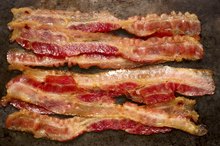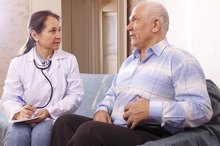Bloated With an Upset Stomach After Every Meal
**Digestion is a complex process that requires coordination of physical and chemical factors.
If you are experiencing serious medical symptoms, seek emergency treatment immediately.
** As you place food in your mouth and begin to chew, you are mechanically breaking it down and exposing it to digestive enzymes, releasing nutrients that will eventually be absorbed into your bloodstream.
This multifaceted activity continues throughout the length of your digestive tract. Disruption of any of a number of digestive processes can cause bloating and an upset stomach after eating.
Food Intolerance
Intolerance to a particular food can manifest as nausea, bloating, belching, excess gas and a change in bowel habits. Lactose intolerance -- an inability to digest the sugar found in milk -- is relatively common.
Similarly, fatty foods, wheat, certain sugars and any number of other foods can cause stomach upset for some people. Sometimes it helps to keep a food diary to identify specific foods that cause digestive upset for you.
- Intolerance to a particular food can manifest as nausea, bloating, belching, excess gas and a change in bowel habits.
- Similarly, fatty foods, wheat, certain sugars and any number of other foods can cause stomach upset for some people.
Delayed Stomach Emptying
Fatty Liver and Gallstones
Learn More
Delayed stomach emptying, known medically as gastroparesis, refers to a reduction in your stomach’s normal churning motion, which is needed to mix and pulverize your food. Reduced stomach motion means that food stays in your stomach longer than normal, frequently resulting in a feeling of fullness, bloating and/or nausea after eating.
Medications, surgery and diabetes are the most common causes of gastroparesis. A January 2011 "Clinical Gastroenterology and Hepatology" article reports that 5 to 12 percent of people with diabetes report symptoms of gastroparesis 5. The condition is more common in people with type 1 diabetes than in those with type 2.
- Delayed stomach emptying, known medically as gastroparesis, refers to a reduction in your stomach’s normal churning motion, which is needed to mix and pulverize your food.
Ulcers
Ulcers are erosions or sores in the lining of your stomach or the first part of your small intestine, called the duodenum. Helicobacter pylori bacteria are present in 95 percent of people with duodenal ulcers and 70 percent of those with stomach ulcers, note the authors of a February 2015 "American Family Physician" article. These spiral-shaped bacteria tunnel into the lining of your stomach or duodenum and incite an inflammatory response that leads to an ulcer. Nonsteroidal antiinflammatory medications, such as aspirin and ibuprofen (Motrin, Advil), are also common causes of ulcers.
Ulcers are classically associated with gnawing abdominal pain that is relieved by eating. Bloating, nausea, heartburn and loss of appetite can also occur.
- Ulcers are erosions or sores in the lining of your stomach or the first part of your small intestine, called the duodenum.
- Helicobacter pylori bacteria are present in 95 percent of people with duodenal ulcers and 70 percent of those with stomach ulcers, note the authors of a February 2015 "American Family Physician" article.
Pancreas and Gallbladder
Digestive Juices & Enzymes
Learn More
Soon after you finish eating, your stomach begins releasing food into your duodenum. There it is mixed with digestive enzymes secreted from your pancreas and bile released from your gallbladder. Malfunction in either of these organs -- due to gallstones or pancreatitis, for example -- results in alterations in the chemical makeup of the material in your duodenum.
This triggers hormonal and nervous system reflexes that interrupt further release of food from your stomach. This digestive slowdown is experienced as bloating and nausea.
- Soon after you finish eating, your stomach begins releasing food into your duodenum.
- There it is mixed with digestive enzymes secreted from your pancreas and bile released from your gallbladder.
Hiatus Hernia
A hiatus hernia is a protrusion of a portion of your stomach through the hiatus -- the opening in your diaphragm leading from your chest to your abdominal cavity. A hiatus hernia sometimes causes bloating and nausea immediately following a meal. This condition is fairly common. At least 40 percent of people getting a chest x-rays are found to have it, according to "The Merck Manual, Professional Version." Although many people with a hiatus hernia do not experience symptoms, food sometimes "sticks" in the portion of the stomach bulging through the diaphragm, leading to a sensation of fullness or bloating 14.
- A hiatus hernia is a protrusion of a portion of your stomach through the hiatus -- the opening in your diaphragm leading from your chest to your abdominal cavity.
- Although many people with a hiatus hernia do not experience symptoms, food sometimes "sticks" in the portion of the stomach bulging through the diaphragm, leading to a sensation of fullness or bloating 1.
Considerations
A variety of problems can lead to abdominal discomfort after a meal. Most of them are not serious and easily diagnosed, while others may require extensive investigation. **In some cases, a change in your diet may be all that is necessary to relieve your symptoms.
** More serious conditions often require medical therapy.
In rare cases, a potentially life-threatening problem -- such as cancer -- can cause bloating and an upset stomach. Therefore, any persistent abdominal symptoms should prompt a visit to your doctor.
Reviewed by: Tina M. St. John, M.D.
- A variety of problems can lead to abdominal discomfort after a meal.
- Most of them are not serious and easily diagnosed, while others may require extensive investigation.
Related Articles
References
- Merck Manual Professional Version: Hiatus Hernia
- American Family Physician: Gastrointestinal Complications of Diabetes
- American Family Physician: Diagnosis and Treatment of Peptic Ulcer Disease and H. pylori Infection
- Merck Manual Professional Version: Peptic Ulcer Disease
- Clinical Gastroenterology and Hepatology: Epidemiology, Mechanisms and Management of Diabetic Gastroparesis
- National Institute of Diabetes and Digestive and Kidney Diseases. Symptoms & Causes of Celiac Disease. Published June 2016.
- National Institute of Diabetes and Digestive and Kidney Diseases. Symptoms & Causes of Diverticular Disease. Published May 2016.
- National Institute of Diabetes and Digestive and Kidney Diseases. Symptoms & Causes of GI Bleeding. Published July 2016.
- National Institute of Diabetes and Digestive and Kidney Diseases. Definition & Facts for GER & GERD. Published November 2014.
- Epelboym I, Mazeh H. Zollinger-Ellison syndrome: classical considerations and current controversies. Oncologist. 2014;19(1):44-50. doi:10.1634/theoncologist.2013-0369
- National Institute of Diabetes and Digestive and Kidney Diseases. Gastritis. Published July 2015.
- National Institute of Diabetes and Digestive and Kidney Diseases. Treatment for Gastroparesis. Published January 2018.
- National Institute of Diabetes and Digestive and Kidney Diseases. Definition & Facts for Gallstones. Published November 2017.
- National Institute of Diabetes and Digestive and Kidney Diseases. Definition & Facts for Diverticular Disease. Published May 2016.
- National Institute of Diabetes and Digestive and Kidney Diseases. Diagnosis of Celiac Disease. Published June 2016.
- National Institute of Diabetes and Digestive and Kidney Diseases. Definition and Facts for Diverticulosis and Diverticulitis. Published May 2016.
- National Institute of Diabetes and Digestive and Kidney Diseases. Gallstones. The National Institute of Diabetes and Digestive and Kidney Diseases. Published November 2014.
- National Institute of Diabetes and Digestive and Kidney Diseases. Gastroparesis. The National Institute of Diabetes and Digestive and Kidney Diseases. Published November 2014.
Writer Bio
Stephen Christensen started writing health-related articles in 1976 and his work has appeared in diverse publications including professional journals, “Birds and Blooms” magazine, poetry anthologies and children's books. He received his medical degree from the University of Utah School of Medicine and completed a three-year residency in family medicine at McKay-Dee Hospital Center in Ogden, Utah.








